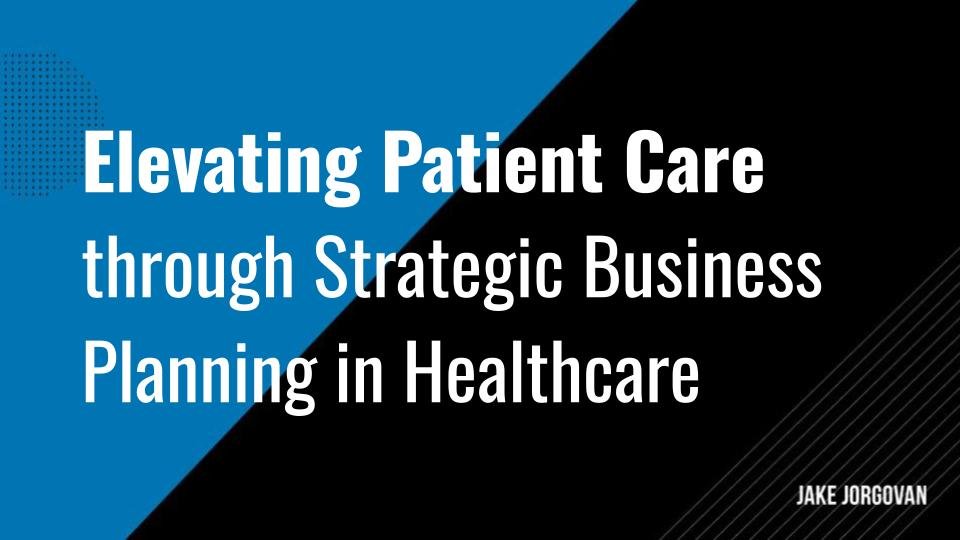Healthcare Business Planning Strategies for Success
For some healthcare organizations, the gap between patient expectations and the quality of care is widening.
However, strategic business planning can serve as a way to close this gap.
If you're feeling overwhelmed by the complexities of enhancing patient care, you're in the right place.
This article will guide you through:
The importance of strategic business planning in healthcare
The 5 key ways strategic business planning elevates patient care
Best practices for strategic business planning in healthcare
Continue reading to discover how strategic business planning can transform patient care in your healthcare organization.
The Importance of Strategic Business Planning in Healthcare
Strategic business planning in healthcare is essential for navigating the industry's complexities. It ensures organizations can effectively respond to evolving regulations, technological advancements, and changing patient needs. A well-crafted strategic plan aligns an organization’s resources with its goals, facilitating improved patient care, operational efficiency, and financial stability.
One core aspect of strategic planning is market analysis. Understanding the healthcare landscape, including competitor actions and consumer trends, allows for informed decision-making. It helps healthcare organizations identify opportunities for growth and areas requiring improvement. According to the Centers for Medicare & Medicaid Services (CMS), national health expenditures are projected to reach $6.2 trillion by 2028, growing at an average annual rate of 5.4% from 2019.
“Because national health expenditures are projected to grow 1.1 percentage points faster than gross domestic product per year on average over 2019–28, the health share of the economy is projected to rise from 17.7 percent in 2018 to 19.7 percent by the end of the period.” (CMS findings, 2020)
Risk management is another critical component. The healthcare sector faces unique challenges, such as cybersecurity threats and compliance with healthcare regulations. In fact, the average cost of a data breach in the healthcare industry reached $10.93 million in 2023, the highest among all sectors. Strategic planning helps identify these risks early, allowing organizations to implement preventative measures and mitigate potential impacts. Clinical operations consulting firms, are firms that helps assess and address these operational risks in clinical settings.
Technology integration also plays a significant role in modern healthcare strategies. Leveraging digital tools can enhance patient experiences, streamline operations, and support data-driven decisions. Strategic planning guides the adoption of technology that aligns with an organization’s objectives and capabilities. There are also medical device consultants that play a crucial role in selecting and integrating these technologies into patient care strategies. Partnering with a telemedicine app development company can further optimize healthcare delivery by providing innovative, user-friendly platforms for remote consultations and patient management.
Additionally, financial planning cannot be overlooked. It ensures that resources are allocated efficiently, maximizing the return on investment while maintaining high-quality patient care. A strategic approach to financial management supports sustainability and growth.
Insider tip: In our experience, prioritizing flexibility in your strategic plan is a must. The healthcare industry is rapidly evolving. Plans should be revisited and adjusted regularly to reflect changes in the environment, technology, and patient needs. We’ve found that setting short-term milestones within the broader strategy helps maintain focus while allowing for necessary adjustments. This approach keeps the organization agile, enabling it to seize new opportunities and tackle challenges effectively.
5 Key Ways Strategic Business Planning Elevates Patient Care
1) Better Alignment of Resources
Aligning resources in healthcare directly elevates patient care by ensuring that investments are strategically placed where they can have the most significant impact on patient outcomes.
To improve efforts in this area of planning, start by conducting a needs assessment. This involves evaluating your organization's current state of patient care, identifying gaps in care delivery, areas of resource underutilization, and opportunities for improvement. It may also include analyzing patient feedback, treatment outcomes, and operational efficiency.
Next, prioritize high-impact areas, focusing on those that will benefit most from additional resources. This might involve investing in specialized training for staff in high-demand areas, upgrading medical equipment to enhance diagnostic accuracy, or enhancing IT systems for improved patient data management.
Finally, implement targeted resource allocation by setting priorities and allocating resources deliberately. This could mean reallocating budgets toward hiring additional specialists in areas with high patient demand or investing in new technologies that improve patient diagnosis and treatment.
Real-Life Example:
An example of strategic resource allocation in healthcare is the SHARE program at Monash Health in Australia. This initiative aimed to investigate and improve decision-making processes for resource allocation within a large health service network. Through detailed case studies, the program explored how resources were allocated, the factors influencing these decisions, and the experience with disinvestment.
By using a comprehensive approach that included environmental scans, interviews, workshops, and document analysis, Monash Health sought to enhance its allocation of monetary and non-monetary resources across various healthcare services. This effort illustrates the practical application of strategic resource planning in addressing the complex needs of a healthcare setting.
2) Increased Innovation and Technology Integration
Innovating and integrating technology in healthcare can significantly enhance patient care by providing more accurate diagnoses, personalized treatments, and efficient care delivery.
For example, Mayo Clinic's use of AI to improve cancer detection and diagnosis showcases how technology can elevate patient care. This partnership focuses on using AI to automate the contouring process during radiotherapy planning, a critical but time-intensive step where clinicians delineate tumors and nearby healthy tissues to optimize treatment delivery while minimizing harm to adjacent healthy tissues. Traditionally, this process could take up to several hours per patient, but with AI, the goal is to significantly reduce this time, thus expediting treatment planning and potentially improving patient outcomes.
To get started in your own organization, it's important to implement telehealth solutions to offer remote consultations, reduce wait times, and make healthcare more accessible. You’ll also want to leverage big data analytics to predict health trends, manage chronic diseases more effectively, and personalize patient care plans.
Additionally, you should invest in AI and machine learning for diagnostic support, treatment planning, and efficient management of health records. In fact, by 2025, the global market for AI in healthcare is projected to reach $38.66 billion, reflecting the growing importance of data-driven approaches in medical care.
3) Amplified Risk Management
Risk management in healthcare is pivotal for elevating patient care, focusing on identifying, assessing, and controlling threats to an organization's capital and earnings. These threats or risks could stem from a wide range of sources, including financial uncertainties, legal liabilities, strategic management errors, accidents, and natural disasters.
Here’s how you can leverage risk management to elevate patient care:
Implement comprehensive risk assessments: Regularly conduct risk assessments to identify potential risks impacting patient safety and care quality. This step includes analyzing historical data, incident reports, and near-miss events to predict and prevent future occurrences. For instance, a systematic review found that approximately 6% of patients experience preventable harm in medical care settings, underscoring the need for thorough risk assessments.
Develop and enforce risk mitigation strategies: Develop strategies to mitigate identified risks based on the assessment findings. This could involve revising clinical protocols, enhancing communication and reporting systems, and investing in staff training on risk management practices.
Adopt a culture of safety: Promote a safety culture within the organization where all staff feel responsible for patient safety and are encouraged to report safety concerns without fear of retribution. This open communication can lead to proactive identification and management of risks.
Johns Hopkins Medicine International's approach involves working closely with clinical providers, leaders, staff, and industry partners on numerous risk issues, including clinical and business processes, patient safety, regulatory standards, compliance, and performance improvement. The solutions offered are customized to stakeholder needs and requirements, beginning with a review of sentinel events root cause analysis (RCA) and examination of event reporting data to identify trends, themes, and potential liability gaps.
4) Enhanced Quality Improvement
Quality improvement initiatives in healthcare focus on raising the standard of care delivered to patients, ensuring safety, and optimizing patient outcomes.
To enhance these efforts, it's essential to establish clear quality improvement goals by identifying specific, measurable objectives based on areas needing improvement, such as reducing readmission rates or enhancing patient satisfaction scores. For instance, in 2020, the 30-day all-cause hospital readmission rate in the United States remained at 13.9 per 100 index admissions, highlighting the need for targeted interventions to reduce readmissions.
A great example of this is Cincinnati Children's Hospital Medical Center. It launched a quality improvement initiative to reduce serious safety events (SSEs) and enhance patient safety culture. This multifaceted approach included error prevention strategies, restructuring patient safety governance, introducing a new root cause analysis process, and implementing tactical interventions for high-risk areas. The initiative led to a significant decrease in SSEs and improved patient safety culture, demonstrating the impact of comprehensive safety and quality improvement strategies in healthcare settings.
Additionally, utilize data for decision making by collecting and analyzing data to understand current performance and pinpoint areas for improvement. This data should be used to track progress toward the established goals.
Finally, evidence-based practices should be implemented by adopting interventions and practices supported by research that have demonstrated a positive impact on patient outcomes.
5) Improved Market Responsiveness
Market responsiveness in healthcare refers to an organization's ability to swiftly adapt to changes in healthcare demands and innovations. This capability is crucial for elevating patient care, as it ensures that healthcare services remain relevant, effective, and patient-centered.
To improve market responsiveness, organizations should stay informed by regularly monitoring healthcare trends, patient needs, and technological advancements. For instance, the U.S. healthcare industry is projected to experience a 7% compound annual growth rate in profit pools, increasing from $583 billion in 2022 to $819 billion by 2027, highlighting the dynamic nature of the market.
It is also important to promote flexibility by developing adaptable strategies and processes that can be quickly modified as market conditions change. Additionally, engaging stakeholders is essential; maintaining open communication with patients, staff, and partners allows organizations to gather valuable insights and feedback.
Real-Life Example:
The expansion of telehealth during the COVID-19 pandemic showcased healthcare institutions' rapid adaptability to changing market demands, significantly elevating patient care by offering remote access to services. This shift was supported by increased consumer and provider willingness to use telehealth, alongside regulatory changes facilitating access and reimbursement. McKinsey highlights that telehealth utilization has stabilized at levels significantly higher than pre-pandemic, indicating a lasting transformation in healthcare delivery.
Best Practices for Strategic Business Planning in Healthcare
Implementing strategic business planning in healthcare requires a meticulous approach tailored to the unique challenges and opportunities of the sector.
“In healthcare, the biggest challenge is not learning, but unlearning. We must unlearn past practices to make room for innovation that benefits both patients and providers.” - Atul Gawande, Surgeon and Author
Let’s explore some best practices to ensure effective planning and execution.
Stakeholder engagement: Start by involving key stakeholders, including healthcare professionals, management, patients, and payers. Their insights can identify real-world challenges and opportunities, ensuring the plan addresses the needs of those it impacts directly. For example, 85% of healthcare executives consider engaging stakeholders essential to meeting organizational goals.
Data-driven decision-making: Utilize quantitative data and qualitative insights for decision-making. Analyze patient demographics, market trends, healthcare regulations, and technological advancements. This approach ensures strategies are grounded in reality and can anticipate future shifts in the healthcare landscape. With data-driven strategies, healthcare organizations could achieve up to a 50% improvement in patient outcomes and cost efficiency.
Clear vision and objectives: Define a clear, achievable vision. Objectives should be Specific, Measurable, Achievable, Relevant, and Time-bound (SMART). This clarity guides the strategic direction and helps in measuring progress.
Integrated care models: Embrace models that promote collaboration across different healthcare services. This can improve patient outcomes and efficiency. Your strategies should integrate services, technology, and care pathways to provide seamless patient care. Studies show that integrated care can lead to a 20-30% reduction in hospital admissions, underlining the efficiency gains and enhanced patient outcomes that integrated models can deliver.
Technological adoption: Invest in technology that enhances patient care, operational efficiency, and data security. Technology should be leveraged to streamline operations and improve patient outcomes, from telemedicine to artificial intelligence. Ensure the plan includes a framework for evaluating, implementing, and adapting new technologies. Notably, the adoption of electronic health records (EHRs) has increased to 89% among healthcare providers, reflecting a significant shift towards digitalization in healthcare.
Financial sustainability: Develop a financial strategy that ensures long-term sustainability. This includes diversifying revenue streams, cost management, and investment in growth areas. Financial planning should also consider the impact of regulatory changes and market dynamics on revenue and costs.
Regulatory compliance: Healthcare is highly regulated. Strategic plans must include mechanisms to ensure compliance with current regulations and adaptability to future changes. This includes privacy laws, quality standards, and billing practices.
Continuous improvement: Implement a culture of constant improvement. Use performance metrics to monitor progress and identify areas for improvement. The strategic plan should be a living document, regularly reviewed and adjusted in response to performance data and external changes.
Communication and transparency: Maintain open lines of communication with all stakeholders. Transparency about goals, progress, and challenges fosters trust and encourages collaboration.
Deliver Better Patient Care Today
In this article, we explored the role strategic business planning plays in enhancing patient care within healthcare settings. We discussed various strategies and their impact on service quality and patient satisfaction.
Strategic business planning is crucial for elevating patient care by ensuring that healthcare services are efficient, responsive, and patient-centered. Focusing on long-term goals and adapting to changes in the healthcare environment allows you to improve patient outcomes and operational efficiency.
As we look to the future, it's clear that the path to better patient care is through thoughtful and proactive strategic planning. Consider the insights and strategies shared in this article as a foundation for enhancing patient care in your own healthcare setting.
Your efforts in strategic planning today can significantly improve patient care tomorrow.
























